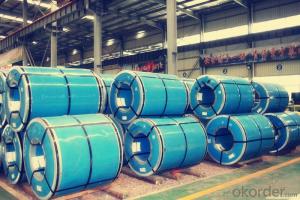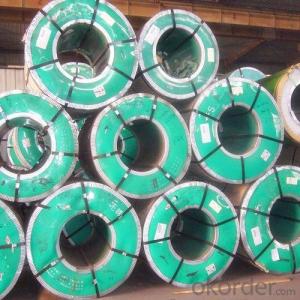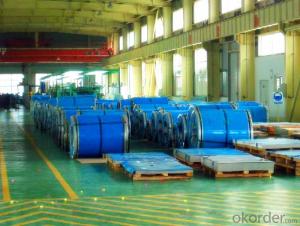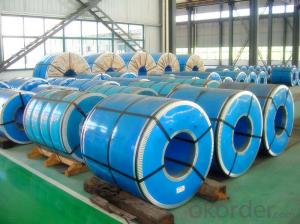Stainless Steel Coil/Sheet 304 Cold Rolled BA/NO.1
- Loading Port:
- Ningbo
- Payment Terms:
- TT OR LC
- Min Order Qty:
- 100 m.t.
- Supply Capability:
- 20000 m.t./month
OKorder Service Pledge
OKorder Financial Service
You Might Also Like
Chemical composition: | |||||||
C | Si | Mn | Cr | Ni | S | P | |
≤0.07 | ≤1.0 | ≤2.0 | 18.0~20.0 | 8.0~11.0 | ≤0.03 | ≤0.035 | |
mechanical properties: | |||||||
Tensile strength σb (MPa) | Conditions yield strength 0.2 sigma (MPa) | Elongation δ5 (%) | Section shrinkage (%) | Hardness | |||
520 | 205 | 40 | 60 | ≤1 | |||
Standard: | AISI,ASTM,BS,DIN,GB,JIS | Grade: | 304 | Thickness: | 0.3-3.0mm |
Place of Origin: | China Mainland | Brand Name: | CNBM | Model Number: | 304 |
Type: | Steel Coil | Technique: | Cold Rolled | Surface Treatment: | 2B, BA |
Application: | Medical instruments, building, chemical food industry agriculture | Width: | 500-2000mm | Length: | Coil |
finish: | 2B, BA | item: | 304 cold rolled stainless steel coil | density: | 7.93 |
Hot Rolled Stainless Steel Coil 304 Annealing and Pickling No.1 Finish
Stainless steel is a production which not easy rust,acid resistance and corrosion resistance,so it is widely
used in light industry,heavy industry,daily necessities and the decoration industry.
Hot Rolled Stainless Steel Coil 304 Specifications
1.surface:NO.1
2.standard:JIS, AISI, GB
3.width: 0.55m, 0.65m, 1.0m, 1.22m, 1.5m, 2m or requirement
Hot Rolled Stainless Steel Coil 304 Chemical Composition:
(%):C=0.07, Mn=2.00, P=0.045, S=0.030, Si=0.075, Cr=17.5-19.5, Ni=8.0-10.5, N=0.10
Hot Rolled Stainless Steel Coil 304 Physical Properties
Tensile strength σb (MPa) ≥ 520
the conditions yield strength σ0.2 (MPa) ≥ 205,
elongation δ5 (%) ≥ 40
Reduction of ψ (%) ≥ 50,
hardness: ≤ 187
HB; ≤ 90
HRB; ≤ 200H
- Q:What are the limitations of using 111 stainless steel strips?
- There are several limitations associated with using 111 stainless steel strips: 1. Corrosion Resistance: While stainless steel is generally known for its corrosion resistance, 111 stainless steel strips may not have the same level of resistance as other grades. This can make them more susceptible to corrosion in certain environments, such as those with high levels of chloride or sulfur. 2. Strength and Hardness: Compared to other stainless steel grades, 111 stainless steel strips may have lower strength and hardness properties. This can limit their suitability for applications that require high tensile strength or resistance to wear and abrasion. 3. Weldability: Welding 111 stainless steel strips can be challenging due to their higher carbon content. This can result in the formation of carbides during the welding process, leading to reduced weldability and potential brittleness in the heat-affected zone. 4. Magnetic Properties: Unlike some other stainless steel grades, 111 stainless steel strips are generally magnetic. This can limit their use in certain applications where non-magnetic properties are required, such as in electronic devices or sensitive equipment. 5. Availability and Cost: 111 stainless steel strips may be less readily available in the market compared to more common grades. This can make them harder to source and potentially more expensive. 6. Temperature Limitations: 111 stainless steel strips may have limitations when exposed to high temperatures. They may exhibit reduced strength and increased susceptibility to oxidation or scaling, which can restrict their use in high-temperature applications. It is important to consider these limitations when selecting stainless steel strips for specific applications, as they can impact the performance, durability, and cost-effectiveness of the material.
- Q:Can stainless steel strips be used in the semiconductor industry?
- Indeed, the semiconductor industry does employ stainless steel strips. Renowned for its exceptional resistance to corrosion, impressive strength, and enduring nature, stainless steel proves itself as a fitting material for an array of applications within this industry. In the construction of semiconductor equipment, including chambers, wafer carriers, and process tools, stainless steel strips frequently find employment, as they are capable of withstanding unforgiving surroundings and elevated temperatures. Moreover, stainless steel strips may be meticulously designed to meet particular specifications, guaranteeing precision and dependability in semiconductor manufacturing procedures.
- Q:How do stainless steel strips perform in corrosive marine environments?
- Stainless steel strips are highly resistant to corrosion and perform exceptionally well in corrosive marine environments. Due to their unique composition of chromium, nickel, and other alloying elements, stainless steel strips form a protective oxide layer on their surface, which acts as a barrier against corrosive elements such as saltwater, moisture, and atmospheric conditions present in marine environments. This corrosion-resistant property of stainless steel strips makes them ideal for various marine applications such as boat fittings, marine hardware, offshore platforms, and underwater structures. They can withstand the harsh conditions of saltwater, waves, and high humidity, without losing their structural integrity or aesthetic appeal. Furthermore, stainless steel strips offer excellent resistance to pitting and crevice corrosion, which are common types of corrosion encountered in marine environments. This ensures their long-term durability and reliability, even in highly corrosive conditions. Additionally, stainless steel strips are easy to clean and maintain, as they do not require any additional coatings or treatments to protect against corrosion. Regular cleaning with fresh water is typically sufficient to keep them in excellent condition. Overall, stainless steel strips are an excellent choice for corrosive marine environments due to their outstanding corrosion resistance, strength, and longevity. They provide a cost-effective and reliable solution that can withstand the challenges posed by the marine environment, ensuring a long-lasting performance.
- Q:Can stainless steel strips be used in marine vessel construction?
- Yes, stainless steel strips can be used in marine vessel construction. Stainless steel is highly resistant to corrosion, making it an excellent choice for marine applications. It is able to withstand exposure to saltwater, which is highly corrosive, without rusting or deteriorating. Stainless steel strips can be used in various areas of a marine vessel, including the hull, deck, fittings, and equipment. Its durability, strength, and resistance to corrosion make it a reliable material for constructing marine vessels that can withstand the harsh conditions of the ocean.
- Q:Can stainless steel strips be used in the aerospace manufacturing industry?
- Yes, stainless steel strips can be used in the aerospace manufacturing industry. Stainless steel strips possess excellent strength, corrosion resistance, and high-temperature resistance properties, making them suitable for various aerospace applications such as aircraft frames, structural components, engine parts, and fasteners.
- Q:What is the thickness range for stainless steel strips?
- Depending on the specific grade and application, the thickness of stainless steel strips may vary. In general, these strips can be obtained in thicknesses ranging from 0.0015 inches (0.0381 mm) to 0.125 inches (3.175 mm). This extensive range provides versatility for their widespread utilization in industries like automotive, aerospace, construction, and manufacturing.
- Q:Are stainless steel strips suitable for oil and gas applications?
- Indeed, stainless steel strips prove to be apt for oil and gas applications. Thanks to its exceptional corrosion resistance, stainless steel emerges as an ideal choice for deployment in oil and gas settings that frequently encounter corrosive elements. Moreover, stainless steel strips boast remarkable strength and durability, enabling them to endure the rigorous conditions and pressures typically encountered in oil and gas operations. Additionally, they possess commendable heat resistance, ensuring that their mechanical properties remain intact even at extreme temperatures. Such properties render stainless steel strips highly suitable for an extensive array of applications within the oil and gas sector, encompassing pipelines, storage tanks, and offshore platforms.
- Q:Can stainless steel strips be used for structural applications?
- Yes, stainless steel strips can be used for structural applications. Stainless steel is known for its high strength, corrosion resistance, and durability, making it suitable for various structural projects such as building frames, bridges, and support structures.
- Q:Can stainless steel strips be used in oil and gas applications?
- Indeed, oil and gas applications can make effective use of stainless steel strips. Given its exceptional resistance to corrosion, stainless steel proves itself as an optimal choice for environments that involve exposure to corrosive substances like oil and gas. Moreover, stainless steel possesses remarkable strength and durability, both of which are crucial for enduring the high pressure and extreme temperatures typically encountered in oil and gas operations. In this regard, stainless steel strips find utility in various components including pipes, valves, fittings, and tanks, ensuring dependable functionality and longevity throughout the entirety of oil and gas operations.
- Q:Can stainless steel strips be plated or coated with other metals?
- Stainless steel strips have the capability to undergo plating or coating with other metals. This process entails the application of a thin layer of a different metal onto the surface of the stainless steel strip. Typically, this is achieved through electroplating, where the stainless steel strip is submerged in a solution containing metal ions that will adhere to it. An electric current is then passed through the solution, causing the metal ions to bond with the surface of the stainless steel strip. There exist several reasons for the plating or coating of stainless steel strips with other metals. One reason is to enhance the visual appeal of the stainless steel strip. For instance, metals like gold or silver can be plated onto stainless steel strips to provide a more opulent or decorative finish. Another motive for plating or coating stainless steel strips is to enhance their resistance to corrosion. Although stainless steel already possesses high resistance to corrosion, specific plating or coating materials can offer an additional layer of protection against corrosion in certain environments. For instance, zinc can be used to coat stainless steel strips, resulting in galvanized steel with improved corrosion resistance. Furthermore, plating or coating stainless steel strips with other metals can yield functional advantages. For instance, materials like nickel or chromium can be used to coat stainless steel strips, enhancing their hardness or resistance to wear. This can be particularly advantageous in applications where the stainless steel strip will be subjected to extensive usage or abrasion. To summarize, stainless steel strips can undergo plating or coating with other metals to enhance their appearance, improve their resistance to corrosion, or provide functional benefits such as increased hardness or resistance to wear. The plating or coating process involves the application of a thin layer of another metal onto the surface of the stainless steel strip through electroplating.
1. Manufacturer Overview |
|
|---|---|
| Location | |
| Year Established | |
| Annual Output Value | |
| Main Markets | |
| Company Certifications | |
2. Manufacturer Certificates |
|
|---|---|
| a) Certification Name | |
| Range | |
| Reference | |
| Validity Period | |
3. Manufacturer Capability |
|
|---|---|
| a)Trade Capacity | |
| Nearest Port | |
| Export Percentage | |
| No.of Employees in Trade Department | |
| Language Spoken: | |
| b)Factory Information | |
| Factory Size: | |
| No. of Production Lines | |
| Contract Manufacturing | |
| Product Price Range | |
Send your message to us
Stainless Steel Coil/Sheet 304 Cold Rolled BA/NO.1
- Loading Port:
- Ningbo
- Payment Terms:
- TT OR LC
- Min Order Qty:
- 100 m.t.
- Supply Capability:
- 20000 m.t./month
OKorder Service Pledge
OKorder Financial Service
Similar products
New products
Hot products
Related keywords





























